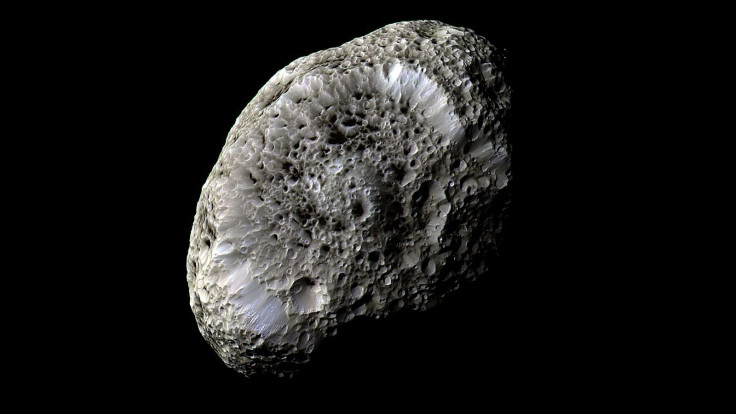Saturn’s Wild Moon Hyperion Set For Final Close Approach By NASA’s Cassini

NASA's Cassini spacecraft is preparing for yet another close encounter with Saturn's large, irregularly shaped moon, called Hyperion, on Sunday, as part of the Cassini-Huygens mission. But this time, it will be Cassini’s final up-close look at the moon, which is known for its unruly rotation while orbiting the ringed planet.
During its last approach, Cassini will pass Hyperion at a distance of about 21,000 miles at 9:36 a.m. EDT, and images of the encounter are expected to arrive on Earth within the next two days. The scientists involved in the mission also expect to see details of terrain that would be different from what Cassini has previously explored.
Hyperion, which is about 168 miles across, “rotates chaotically, essentially tumbling unpredictably through space as it orbits Saturn,” NASA said in a statement on Friday, adding that the moon’s disorderly rotation makes it difficult for astronomers to target a specific region of its surface. According to the federal space agency, most of Cassini's previous close approaches have come across more or less the same familiar side of the rocky moon.
It's time for one last close look at Saturn's tumbling moon Hyperion. http://t.co/WBF8eumvIh pic.twitter.com/nrYj7pls8D
— CassiniSaturn (@CassiniSaturn) May 28, 2015Scientists said that Hyperion has an odd, sponge-like appearance because of its unusually low density -- about half that of water -- for such a large object. The low density makes Hyperion quite spongy with weak surface gravity, which means that impacts with other celestial objects are likely to compress its surface, rather than excavating it.
Cassini's closest-ever flyby of Hyperion occurred on Sept. 26, 2005, when the spacecraft passed Saturn’s moon at a distance of 314 miles.
“Cassini's next notable flyby after May 31 is slated for June 16, when the spacecraft will pass 321 miles (516 kilometers) above icy Dione,” NASA said. “In October, Cassini will make two close flybys of the active moon Enceladus, with its jets of icy spray, coming as close as 30 miles (48 kilometers) in the final pass.”
The Cassini-Huygens mission is a cooperative project of NASA, the European Space Agency and the Italian Space Agency. In 2005, the spacecraft found evidence of an icy spray issuing from the southern polar region of Saturn’s sixth-largest moon, Enceladus.
Researchers recently confirmed the presence of hydrothermal activity on Enceladus, followed by their statement two months later that the eruption of water vapor on its surface might be in the form of broad, curtain-like sheets, rather than discrete jets.
© Copyright IBTimes 2025. All rights reserved.






















